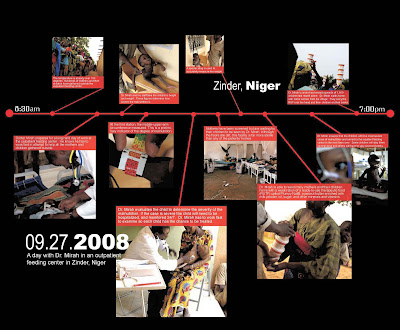
Monday, September 29, 2008
Thursday, September 25, 2008
Tuesday, September 23, 2008
Monday, September 22, 2008
Aid in Innovation
 Andrew Mwenda, of Uganda, can appreciate the global efforts that bring millions of dollars of Aid into Africa, but he describes how the Aid is designed to treat the symptoms and not address the fundamental problems. Many Governments in Africa become dependent on Aid. He believes that it is easier for African Governments to value their relationship with the Aid suppliers more than their relationship with the citizens. This relationship begins to strip the Governments of their self initiative. Mwenda describes how the only way for truly sustainable development in Africa is to design ways to create wealth. Current solutions focus on "reducing poverty". Well you can not begin to reduce poverty until you begin to create wealth. He believes that the solution is innovation and Entrepreneurship.
Andrew Mwenda, of Uganda, can appreciate the global efforts that bring millions of dollars of Aid into Africa, but he describes how the Aid is designed to treat the symptoms and not address the fundamental problems. Many Governments in Africa become dependent on Aid. He believes that it is easier for African Governments to value their relationship with the Aid suppliers more than their relationship with the citizens. This relationship begins to strip the Governments of their self initiative. Mwenda describes how the only way for truly sustainable development in Africa is to design ways to create wealth. Current solutions focus on "reducing poverty". Well you can not begin to reduce poverty until you begin to create wealth. He believes that the solution is innovation and Entrepreneurship. Ernest Madu agrees with Mwenda and sees innovation and technology as the key to development in Africa. He focuses on bringing innovation to the health care system, enabling African hospitals and treatment centers to supply world class health care at 1/8 the cost of more developed countries. He says the solution is to use wireless technology to train African doctors, create modular/movable medical equipment, and assembling all equipment in house. These small changes will drastically decrease the cost of health care. It appears the greatest impact we can have in Africa is to design products, systems or serveses that are fully sustained by local recources and local workers.
Monday, September 15, 2008
Our Future is in the Trash
 This product concept won the 2008 Greener Gadgets Design Competition held by Core 77. It was one of many entries that's primary function is to measure or display energy consumption. What makes this design so legit is the fact that the innovation is not the physical product but a set of instructions to build a meaningful product from easily accessible components and a reused jar. I have to admit, the shinny white plastic renderings on the reflective surfaces are very appealing, but I think there is a good chance that many products in the distant future will more likely resemble this jar. Is it possible that our design practice could become so green that we don't even touch a raw material.
This product concept won the 2008 Greener Gadgets Design Competition held by Core 77. It was one of many entries that's primary function is to measure or display energy consumption. What makes this design so legit is the fact that the innovation is not the physical product but a set of instructions to build a meaningful product from easily accessible components and a reused jar. I have to admit, the shinny white plastic renderings on the reflective surfaces are very appealing, but I think there is a good chance that many products in the distant future will more likely resemble this jar. Is it possible that our design practice could become so green that we don't even touch a raw material.
Sunday, September 14, 2008
Design for Social Entrepreneurship

De-SE
I signed up for this class because I ave always had an interest in social enterprise. In the past 5 years I have been exposed this field of work through my father. He is the director of Zen Peacemakers, an organization that focuses on socially engaged Buddhism. For their primary source of income they develop socially responsible businesses that are centered on a triple bottom line and sell them once they have become financially independent.
Greyston Bakery
One example is Greyston Bakery Founded in 1982 in the southwest corner of
Change
There are so many organizations that are working to improve our quality of life, and minimize our impact on the environment. I want the opportunity to design the tools, and products, that these organizations will need to facilitate change.
Subscribe to:
Comments (Atom)


